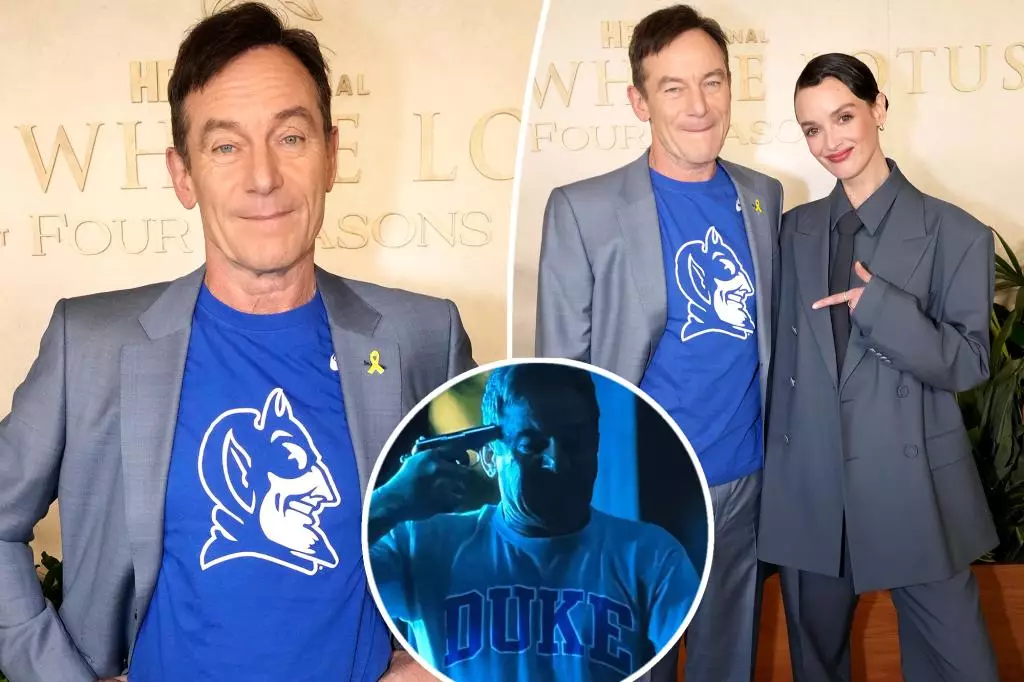In a world where the line between artistic freedom and institutional propriety often blurs, Jason Isaacs recently stirred the pot while attending the finale of HBO’s acclaimed series “The White Lotus.” Wearing a gray suit over a striking blue Duke University t-shirt, Isaacs showcased a deliberate affinity to his character, Timothy Ratliff, invoking discussions around branding, identity, and representation. His choice poses a rich commentary on how popular culture engages with collegiate imagery, particularly when done in a manner deemed as ironic or controversial by the institutions involved.
The Tension with Duke University
Duke University’s swift response to Isaacs’ choice of attire highlights an ongoing challenge faced by institutions: managing their brand’s portrayal in entertainment. The show aired a scene featuring Ratliff contemplating suicide while adorned in Duke insignia—an indisputably jarring image that has sparked discontent among the university’s administration. Their concerns revolve not just around the use of the logo but also the deeper implications this portrayal could have on public perception. Is Duke merely a symbol now, commodified for dramatic effect? The calculated statements from Frank Tramble, the university’s vice president, underline their dilemma—balancing appreciation for creativity with protecting institutional integrity.
Cultural Commentary on Artistic Expression
It’s easy to appreciate the colorful spectacle of red carpets and glamorous attire, yet what lies beneath is rich material for cultural critique. The tension between creative storytelling and the ethics of representation serves as a potent reminder that art does not exist in a vacuum. Whether it’s a position of pride or a source of controversy, the image of Duke University, plastered across a series like “The White Lotus,” compels individuals to ask larger questions: What do brands signify in our identities? And how do we respond when those brands are mishandled in art? The university’s reaction indicates a discomfort with how their persona can morph into something unrecognizable within the hands of artists.
The Impact of Viral Culture
As the incident gained traction online, the Duke logo morphed into a meme—a rapid escalation into the digital culture that can warp the original narrative into something entirely different. In the face of Duke’s dismay, social media users have hijacked the imagery, often using it in playful or sarcastic contexts unconnected to the gravity of the show’s content. This speaks to a larger phenomenon—how viral culture can recontextualize and trivialize serious subjects. The viral dissemination of Ratliff’s dilemma reflects a societal tendency to consume tragedy as entertainment, leading to a disconnect between the heaviness of the narrative and its playful reappropriation in online spheres.
Fashion as a Form of Resistance
Isaacs’ ensemble speaks to more than character loyalty; it embodies a subversive challenge against the university’s sanctions. By showcasing a sense of nonchalance towards institutional approval, he advocates for a narrative that critiques the suffocating armor of brand identity. In a moment where many co-stars opted for luxurious attire that aligns with conventional glamour, Isaacs chose to embody the character’s plight, almost demanding the audience to confront their discomfort. Fashion becomes a language of rebellion, one that screams artistic integrity in the face of authoritarian disappointment. As the audience digests the finale, we are left not only with a sense of closure from the season but also a lingering inquiry about identity and the narratives we choose to wear on our sleeves.

